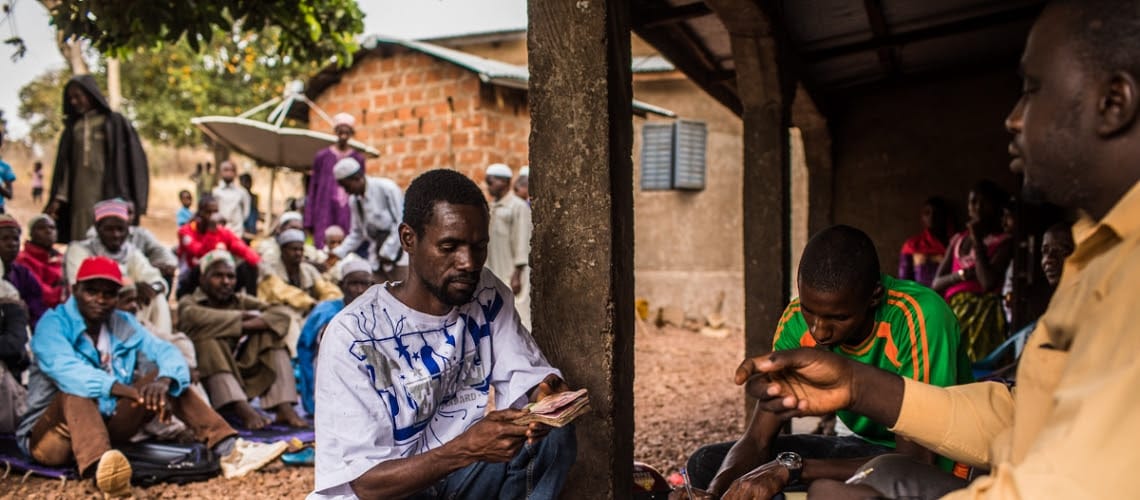
Hafia village, prefecture of Dalaba, Guinea. A man receives money as part of a social net project. © Vincent Tremeau /World Bank
In response to the COVID-19 pandemic, countries across the globe have been adapting social assistance policies to support their populations. In fact, since March 2020, 139 countries and territories have planned, implemented, or adapted cash transfers to support their citizens. Cash transfers specifically make up about half of the social protection programs implemented to address the pandemic. Now more than ever, it’s crucial that such programs are designed to maximize impacts. Behavioral insights can be mobilized as a cost-effective way to help beneficiaries make the most out of the available support. The World Bank and ideas42 partnership on behavioral designs for cash transfer programs is helping countries achieve this goal.
Cash transfers are a key response instrument in the social protection toolkit—and for good reason. Cash transfers have been shown to generate a wide variety of positive benefits, from helping families invest in their children to promoting gender equality. However, we know from our previous work that in order to make the most out of cash transfers, recipients of any program (already facing challenging circumstances that compete for their attention) must undertake complex decisions and actions with their cash. These challenges are only magnified by the global pandemic. COVID-19 has wrought increased uncertainty around future employment and income, which makes calculations and planning to use cash transfer benefits all the more complex.
To help practitioners design programs that account for the complex thought processes and potential barriers recipients face, we mapped out their journey to effectively spend emergency social protection cash transfers. We also created simple, actionable guidance for program designers to put to use in maximizing their programs to help recipients use their cash transfer benefit to most effectively support families and reduce mid- to long-term financial volatility.
For example, the first step is helping recipients understand what the transfer is for. For recipients who have not yet been impacted by financial instability, or indeed have never encountered a cash transfer before, such funds might seem like a gift or bonus, and recipients may spend it accordingly. Providing clear, simple framing or labelling the transfer may signal to recipients that they should use the cash not only for immediate needs, but also in ways that can help them protect investments in their family members’ human capital and jumpstart their livelihood after the crisis wanes.
After enrolling in the program, recipients must then plan how to spend their cash. In order to make a plan that effectively allocates cash for immediate needs and what might be needed in the future, recipients must think about when they might get more support (or when they might have income restored) in the future. Clearly communicating if and when future payments will come can help recipients manage and best allocate the cash they receive.
After completing all other steps in the journey—paying attention to and acting on any additional messages and receiving their cash—recipients must spend the cash according to their plan to help smooth consumption during the crisis and reduce long-term financial volatility.
Barriers can emerge that make it difficult for beneficiaries to stick to their plan. For example, they may look to the spending patterns of others, and decide to deviate from their original plan if it does not match what they see their peers doing. The stress of the crisis may also prompt them to focus on short-term issues, rather than longer-term plans. Simple designs—such as using posters, flyers, SMS or media posts—to communicate norms around productive spending or providing a tool that recipients can use to separate their cash immediately upon receipt—can help recipients stay on track with their own plans.
While suggestions should always be tailored to the context and cultural nuances of each program, and adjusted to minimize risks (health or otherwise) to beneficiaries, this guidance aims to provide principles that can be applied to a wide range of cash transfer programs with a variety of goals.
The current global pandemic and its ensuing economic crisis make it all the more important that cash transfer recipients use the income support as effectively as possible. Light-touch, low-cost tweaks, derived from evidence and a deep understanding of human behavior, can ensure programs are designed in a way that do just that—potentially improving countless lives.
To learn more, get the checklist (in English and French) and infographic (in English and French) that map out the journey to effectively spending cash transfers.


